by Amineddoleh & Associates LLC | Dec 21, 2021 |
In this inaugural newsletter, Amineddoleh & Associates is pleased to share some major developments that took place at the firm during the summer and autumn of 2021.
LITIGATION UPDATES
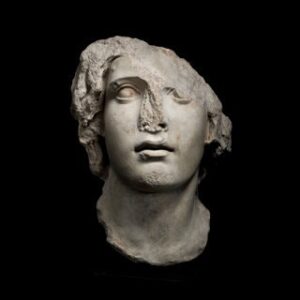
Ancient marble bust contested in lawsuit
Image from Manhattan DA’s Office
A Victory for Our Client, the Republic of Italy
Amineddoleh and Associates secured a win for its client, the Italian Republic, in the ongoing Safani v. Republic of Italy litigation in the U.S. District Court for the Southern District of New York. The court dismissed litigation against our client in a case concerning an Italian antiquity seized from a Manhattan art gallery. Read about the litigation update here and the case details here.
(The Plaintiff has since filed a Second Amended Complaint, naming the Manhattan District Attorney as a defendant in the case.)
ART & IP NEWS
Illicit Antiquities Trafficking
In this blog post, our founder Leila Amineddoleh discusses disgraced art dealer Nancy Wiener, who revealed new details about her involvement in the illicit trafficking of antiquities and its effect on the art market in an allocution statement. Wiener had ties to Douglas Latchford, whose recent appearance in the Pandora Papers leak highlights the global nature of the illicit antiquities trade. Read more on our website.
Nazi-Era Looting, Duress Sales, and New Laws
There were a number of developments this autumn concerning Nazi-Era looting. We presented an entry in our popular Provenance Series to examine the issues surrounding the restitution of looted cultural heritage in Poland, including the country’s history, a new law shortening the applicable statute of limitations, and examples of successful returns. Read more on our website. In addition, questions continue to arise concerning alleged duress sales, with one painting in Houston’s Museum of Fine Arts coming under scrutiny. Founder Leila Amineddoleh discussed the case and its implications with media outlets.
Turkey and Antiquities Restitution
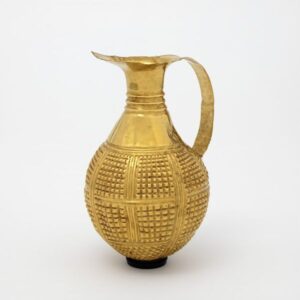
Gold ewer
Image from V&A
Firm founder Leila Amineddoleh consulted with the Gilbert Trust at the Victoria & Albert Museum concerning a 4,250 year old golden ewer that was returned to Turkey in October. The ewer was purchased by a private collector who was unaware of the seller’s dirty dealings, including his involvement in antiquities trafficking. Luckily, the Gilbert Trust was proactive and the matter was resolved amicably and creatively. Read about the ewer’s fascinating history and the details of its return here.
NFT Battle: Miramax v. Tarantino
With the ongoing NFT craze, market participants and legal scholars have been waiting for guidance from courts concerning the application of “traditional” intellectual property law to this new digital asset class. We authored a blog post discussing the legal questions and controversies arising as the NFT market continues to grow. NFTs recently made headlines when Miramax sued Quentin Tarantino. Tarantino, the award-winning movie director, announced his plan to sell a new NFT collection consisting of seven tokens to uncut, exclusive scenes from Pulp Fiction. In response, Miramax sued Tarantino for breach of contract, as well as copyright and trademark infringement. Read more about NFTs and this new lawsuit here.
Lifetime Ban on Collecting: the Steinhardt Seizure
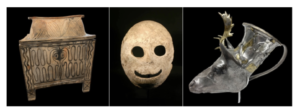
Several artifacts seized from Steinhardt
Image from DA’s Office
This blog post details the Manhattan District Attorney’s Office seizure of 180 looted antiquities from Michael Steinhardt. Steinhardt, a hedge-fund pioneer and one of the world’s most prolific collectors of ancient art, was involved in a criminal investigation examining issues with the provenance of various pieces in his collection. The DA’s Office announced that Steinhardt has been sanctioned by placing him under a lifetime ban on the purchase of antiquities. All of the seized antiquities will be returned to their country of origin. Read more about this news on our website. Our founder served as an independent cultural heritage law expert for the seizure of certain items in Steinhardt’s collection. She discussed this with a number of news outlets, including WNYC.
LAW FIRM UPDATES AND EVENTS
New Team Members
Our firm added two new members to its roster this fall: Travis Mock and Deanna Schreiber. Travis is an attorney with a wealth of experience in litigation, IP law and trademarks, while Deanna is 3L at Fordham Law School interested in both transactional and litigation aspects of art and cultural heritage law. Deanna was the winner of the NY State Bar Association’s writing competition for her submission discussing the Foreign Sovereign Immunities Act and its future role in Nazi-looted art controversies. We wish Travis and Deanna a warm welcome. Learn more about our team and their accomplishments here.
Art Law Conferences
Congratulations to our firm’s founder Leila Amineddoleh, who successfully chaired the 13th Annual NYCLA Art Law Institute, one of the most anticipated events of the year. Leila also spoke on the topic of foreign sovereign immunity while Associate Claudia Quinones participated in the ever-popular What’s New in Art Law? panel, focusing on title disputes. Check out the conference program and speaker details here.
In early December, Leila and Claudia also spoke at an international conference, The Intentional Destruction of the Cultural Heritage of Mankind, organized by Università degli Studi di Roma “La Sapienza.” They discussed cultural heritage as a human right as well as measures of legal protection in times of peace and conflict. In November, Leila presented a 3-hour lecture on the topic of NFTs for the Executive Master in Art Market Studies at the University of Zurich. Earlier in the month, she presented on “New Obligations in the Art & Antiquities Markets” for the Responsible Art Market Initiative. She also presented a featured lecture, “Cultural Heritage, the Law and Looting,” for the Department of Art History at New York University in October. Before that, she spoke about Nazi Looted Art and the Guelph Treasure for the International Center of Medieval Art.
CLIENTS AND REPRESENTATIVE MATTERS
Leader in the NFT Market
Our firm was hired to create a unique template for the sale and purchase of NFTs on Monax. The company’s cutting-edge digital platform will combine technological expertise with art market considerations to provide users with full support for these emerging digital assets. As NFTs continue to increase in price and popularity, this template has the potential to revolutionize the market. Read more about NFTs and Monax’s services here. A&A also advised Nifty Gateway on its Terms & Conditions, and we have been working with a number of clients on new NFT projects.
Artists, Designers & Fashion

Fragrance of Infinity: Hiroshi Sugimoto’s limited edition perfume bottle
Copyright: Diptyque
In honor of Diptyque’s 60th anniversary, our client Hiroshi Sugimoto collaborated with the fragrance house on a limited edition perfume bottle inspired by the Japanese region of Kankitsuzan. The artist used his childhood memory of seeing the ocean for the first time to create a striking form exploring the relationship between man and nature. More information on the collection can be found here.
Public Art Commissions
In honor of Veterans Day, the People’s Picture (our client) was commissioned by America250 to create a digital photo mosaic depicting African American WWI hero Sgt. Henry Johnson for its November Salute 2021. The stunning mosaic, containing hundreds of photographs of veterans and other military personnel, is accessible online here and you can read more about The People’s Picture and their work here.
Artists, Art Dealers & Art Fairs
A number of our artist-clients received recognition for international art exhibitions over the past year, including the talented Kamrooz Aram. In addition, our collector-clients and dealer-clients, including Zeit Contemporary Art, were also actively buying and selling art through both online platforms and in-person art fairs.
Television & Film
As television viewership numbers increase during the pandemic, it is a pleasure to work with producers, writers, and on-screen talent creating exciting programs. One of these clients is Terra Incognita, a company producing content for educational, travel, and documentary programming. They focus on high-quality and thought-provoking ideas to empower audiences around the world.
On behalf of Amineddoleh & Associates, we wish you a happy holiday season and wonderful new year.
by Amineddoleh & Associates LLC | Nov 29, 2021 |

Sack of Rome by the Visigoths on August 24, 410 by JN Sylvestre (1890)
Amineddoleh & Associates LLC is pleased to once again collaborate with the American Institute for Rome Culture by contributing to the excellent series on its WEBSITE. Our most RECENT ARTICLE examines the legal tools used to fight against the destruction, looting, and illicit trafficking of cultural goods. The piece traces both national and international efforts made to protect heritage, with an emphasis on work by Italian authorities to protect its cultural goods.
by Amineddoleh & Associates LLC | Aug 6, 2021 |
On August 2, 2021, the Southern District of New York granted our motion to dismiss a case brought against the Republic of Italy. The case involved a marble bust (purportedly discovered in the Roman Forum) that was for sale by the Safani Gallery. We discussed the litigation and our motion to dismiss in a prior blog post. The highly anticipated opinion concerned the applicability of the Foreign Sovereign Immunities Act (FSIA) to the Republic of Italy; namely, whether Italy acted in such a manner that a U.S. court could obtain subject matter jurisdiction over it. The FSIA is the only means for US courts to obtain jurisdiction over foreign states, through a series of limited statutory exceptions. The court ruled that plaintiff Safani Gallery failed to establish grounds satisfying any of the exceptions named in its Amended Complaint. (The gallery initially alleged that Italy engaged in commercial activity, but then amended its complaint to instead allege waiver, expropriation, and tortious activity). In particular, the court noted that Italy did not engage in a taking in violation of international law, nor did it exert agency over the N.Y. law enforcement officials who seized the object in Manhattan. Judge Vernon Broderick noted that Italy’s communication with the District Attorney’s office was analogous to someone who reports a crime, which was insufficient to establish a fiduciary relationship. The seizure of the object was also carried out for a public purpose and was therefore lawful.
This case is the third in a line of litigations in which art market participants have sued foreign governments for communicating about problematic or suspicious antiquities. This is also the third case in that line of cases to be dismissed. The first of those litigations, Barnet et al. v. Ministry of Culture of the Hellenic Republic, involved an antiquity up for auction at Sotheby’s. Amineddoleh & Associates is proud to have represented Greece in the landmark case and to have secured a win for the nation. There, the Second Circuit Court of Appeals granted our motion to dismiss on behalf of Greece in June 2020. We are pleased that US courts have upheld foreign states’ defense from actions suing them for communicating with law enforcement or art market participants. Our firm is proud to have gained recognition as a leader in FSIA litigations and antiquities matters.
by Amineddoleh & Associates LLC | Jul 23, 2021 |
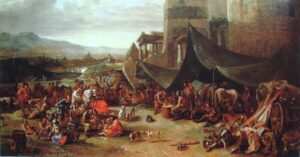 Amineddoleh & Associates LLC is pleased to contribute to the Preserving History Series by the American Institute for Roman Culture (AIRC). AIRC, founded in 2002, is a non-profit organization with locations in both the United States and Italy. The organization provides educational content, conducts archeological fieldwork, and provides its study abroad students with a full immersion into modern Italian culture while learning about the nation’s rich past. A lauded organization, AIRC has received numerous grants, including an NEH grant, American Express Foundation grant for the Villa delle Vignacce excavation, World Monuments Fund (WMF) collaboration for Santa Maria project, anonymous angel grants, and numerous donations from supporters. Its founder and director, Darius Arya, has received acclaim for his television and outreach work.
Amineddoleh & Associates LLC is pleased to contribute to the Preserving History Series by the American Institute for Roman Culture (AIRC). AIRC, founded in 2002, is a non-profit organization with locations in both the United States and Italy. The organization provides educational content, conducts archeological fieldwork, and provides its study abroad students with a full immersion into modern Italian culture while learning about the nation’s rich past. A lauded organization, AIRC has received numerous grants, including an NEH grant, American Express Foundation grant for the Villa delle Vignacce excavation, World Monuments Fund (WMF) collaboration for Santa Maria project, anonymous angel grants, and numerous donations from supporters. Its founder and director, Darius Arya, has received acclaim for his television and outreach work.

Flayed Marsyas at Centro Montemartini
One of the finds from the organization’s excavations can be viewed at Centrale Montemartini in Rome. In 2009, during a four-year excavation conducted by the Sovrintendenza Capitolina and AIRC, at Villa Vignacce in southeastern Rome, a statue in red marble was discovered. Dating from the 1st half of the 2nd century, it depicts the punishment of Marsyas. Marsyas was a satyr who challenged Apollo to a music contest. When Marsyas lost, Apollo had him tied to be flayed alive. In the Vignacce Marsyas, the bloodied skin is rendered by head, arms, torso and legs of a veiny red marble, while hands and feet would have been white marble. An extraordinary find, the statue is almost entirely intact, missing only one hand and both feet.
Amineddoleh & Associates LLC has a long history collaborating with AIRC, and we are pleased to contribute a series of post entries to the Preserving History Series.
by Amineddoleh & Associates LLC | Oct 9, 2020 |
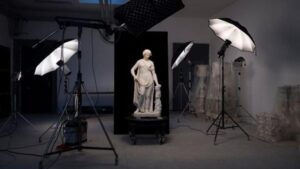
Photo session for Maenad statue at via della Lungara in Rome, ©FondazioneTorlonia, Ph. Lorenzo de Masi.
Not only do objects have provenances, but so do collections. One of the world’s finest privately held collections will be shared with the public starting later this month. The collection is housed in Rome, and while it is difficult to travel during this time, we are pleased to share a blog post about the upcoming exhibition in Italy. The following blog post was written by colleagues in Italy at Milestone Rome. Founded by two Roman locals, Milestone Rome is an independent cultural project aimed at spreading appreciation for the Eternal City and disseminating knowledge about its rich cultural heritage through art historical information enhanced by digital technologies. The group promotes academic-quality cultural content, and its website and app are also wonderful resources for travelers who visit Rome. Amineddoleh & Associates is pleased to share Milestone Rome’s post with our readers. Read more about the group on its great website.
The Storied Torlonia Collection of Ancient Marbles is Finally on View in Rome
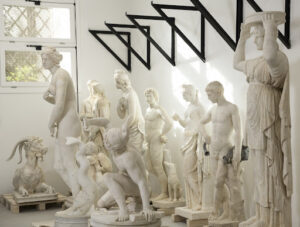
Group of restored statue at via della Lungara in Rome, ©FondazioneTorlonia, Ph. Lorenzo de Masi.
Almost 100 exquisite marble sculptures belonging to the renowned Torlonia Collection will be shown to the public on the occasion of the long-awaited exhibition I marmi Torlonia: Collezionare capolavori (“The Torlonia Marbles: Collecting Masterpieces”). After a turbulent year of delayed cultural events, the highly anticipated exhibition will be on view at the Capitoline Museums in Rome from October 14, 2020 until June 29, 2021. This will be its first stop on an unprecedented world tour. The exhibition is curated by two archaeologists and academics from the Accademia dei Lincei, famed Italian art historian Salvatore Settis (who was entrusted with the scientific project) together with art historian and professor Carlo Gasparri. The event is made possible thanks to a historic agreement between the public Italian Ministry of Cultural Heritage and Activities and Tourism and the private Fondazione Torlonia.
The successful negotiation, reached in 2016, comes after many years of a complex disputes between the noble Torlonia family and the Italian State. For this reason, the collection was hidden to the public for over 40 years. As a result, the exhibition in Rome will surely be one of the most important art events of the year or even of the decade.
The Troubled History of the Torlonia Collection
The Torlonia Family is a noble family from Rome that acquired a massive fortune in the 18th and 19th centuries overseeing finances for the Vatican. With its wealth, the family became major collectors of art. In fact, the complete Torlonia Collection is much larger than the selection of 96 pieces to be displayed as part of the exhibition. The collection includes 620 artworks that were catalogued in 1881 by Pietro Ercole Visconti as the result of a long series of acquisitions and excavations. The collection grew as the family purchased entire art collections that belonged to princely families in decline, such as the Giustiniani Collection. The Torlonia Collection was housed in a number of residences owned by the noble family, adding to the family’s prestige and title.
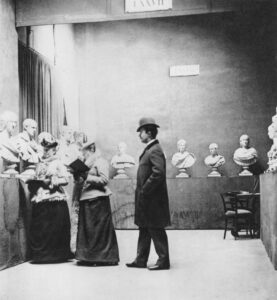
Giuseppe Primoli, A visit to the Torlonia Museum, 1898 ca., image via Wikimedia Commons.
The history of the Torlonia Collection took a turn at the beginning of the 19th century. At the time, it began assuming the form of a museum collection thanks to the Prince Alessandro Torlonia. In 1866, the prince acquired the villa of distinguished Cardinal Alessandro Albani. The villa is in Rome, located along the Via Salaria. When the prince acquired the villa, he also purchased the impressive collections of paintings and Greek and Roman sculptures found within. By the end of the 19th century, the collection included an extraordinary number of ancient marbles. Around 1875, the Prince Alessandro promoted a project to establish a Museum of Ancient Sculpture in an old grain warehouse along Via della Lungara near Palazzo Corsini. Dubbed “Torlonia Museum” it was open to small groups of visitors. But the project didn’t last, since in 1976 the building was converted into housing units and the collection locked up. The 2020 exhibition will display artworks that have not been on view since the 1970s.
Nowadays, the celebrated Torlonia Collection is not publicly visible, but it is the “most important private collection of ancient sculpture existing in the world,” according to the well-known art historian and critic Federico Zeri. What’s more, it is significant for many fields of study, including art history, archaeology, collecting history, restoration and museology. Due to the high-quality and complex nature of several collection which joined it, the Torlonia Collection has been then called “the collection of all collections.”
The Value of the Extraordinary Exhibition
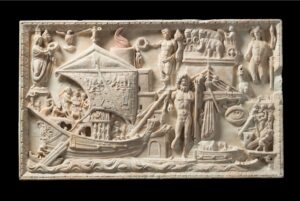
Porto relief, Torlonia Collection, ©FondazioneTorlonia, Ph. Lorenzo De Masi.
The anticipation surrounding this exhibition derives from many things. The art historical value of the sculptures themselves is incredible. The items include busts, reliefs, statues, sarcophagi, decorative elements and rare archaeological findings which have been always deemed as outstanding examples of ancient art. Also, the collection itself has an interesting history, as it was acquired over the centuries from a number of notable Romans. Moreover, the collection offers the opportunity to understand the prestigious and long history of antiquities collecting in Rome over a span of four centuries, between the 15th and the 19th century.
This is highlighted by the curators’ decision to configure the final room of the exhibition next to the Exedra of Marcus Aurelius, featuring the Lateran Ancient bronzes which were donated in 1471 by Pope Sisto IV’s to the “Roman People” and constituted the nucleus of what is considered as the first public museum in the world. In this way, the relationship between private collecting and public ownership are visually explained, highlighting the influential role of Rome in the art world.
A Torlonia Museum in Rome?

Statue of a goat at rest, Torlonia Collection ©FondazioneTorlonia, Ph. Lorenzo de Masi.
After being displayed at the newly restored exhibition venue at the Capitoline Museums in Rome, the traveling exhibit will tour around the world at a number of prestigious museums. As the details about these international agreements are revealed, the event schedule will be disclosed. It is also expected that the exhibition will end with the revelation of a permanent home in Rome, to be chosen by the Municipality of the City together with the Torlonia Family. This final home will permanently house the collection. This coveted collection will be yet another jewel in the crown of Rome’s artistic and cultural crown.
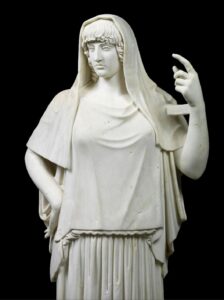
Hestia Giustiniani, Torlonia Collection, ©FondazioneTorlonia, Ph. Lorenzo De Masi.

Old man from Otricoli, Torlonia Collection, ©FondazioneTorlonia, Ph. Lorenzo De Masi.





 Amineddoleh & Associates LLC is pleased to contribute to the
Amineddoleh & Associates LLC is pleased to contribute to the 






